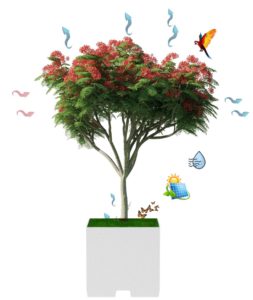A new smart planter is set to provide a simple and efficient way to restore urban tree cover in hard-to-plant places—such as on buildings—thus reducing the urban heat island effect and boosting climate resilience.
In Queensland, Australia, Griffith University PhD student Majed Abuseif has just been announced as a finalist in the QBE AcceliCITY Resilience Challenge for his project using artificial intelligence and simulation models to incorporate green infrastructure into building and the urban environment.
The global competition seeks entrepreneurs whose ventures use smart city solutions to address risk, equity and sustainability in our urban environments and has narrowed it down to the ten best solutions.
 Working as an architect and landscape architect, Abuseif’s PhD focuses on the implementation of trees on buildings, and building science and environmental simulations.
Working as an architect and landscape architect, Abuseif’s PhD focuses on the implementation of trees on buildings, and building science and environmental simulations.
“The smart planter box enables us to green buildings and surfaces, indoors or outdoors, in any environment,” he said. “It is a novel modular system capable of supporting standard plants and trees.”
Scientists have been trying to redress the growing ecological imbalance caused by urban development by incorporating certain types of green infrastructure such as green roofs and walls, but unfortunately the technologies available to date have been limited and need infrastructure to host them.
Putting plants on buildings generally presents risks that hinder their implementation, such as plant roots, wind loads, waterproofing, irrigation requirements and other problems.
Abuseif engaged with industry partners and worldwide experts trying to integrate trees on buildings by incorporating rooftop gardens.
“I found some traditional technologies that could be used on buildings, then started developing a design based on a modular system that can be put on any surface and any location,” he explained. “The planter box can be integrated into existing infrastructure, or act as a stand-alone planter.”
The system can even be connected to Smart Cities and Smart Building models, so councils and developers can obtain better insights on climate change and urban heat islands to help with development of mitigation strategies.
“We could put this system in a forest and develop it to mimic a bushfire situation, so when there is a risk of a bushfire it will give us the alarm and we could act before a disaster happens,” he continued. “Because the system has a water compartment, it can harvest water, so it can also help mitigate stormwater flooding issues in the city.”
Abuseif said the smart planter box is a closed system so it can mimic any environment.
“We can even use this system to predict the energy consumption of buildings, and to validate the environment aspect of a building,” he added. “Architects will be able to use this as a design tool and a research tool, which will help in designing sustainable buildings as well as monitoring them.”
“The next step is to deliver my skills and design for people around the world, helping to save our planet and enhancing people’s lifestyles,“ Abuseif concluded.
Images courtesy of Griffith University.

